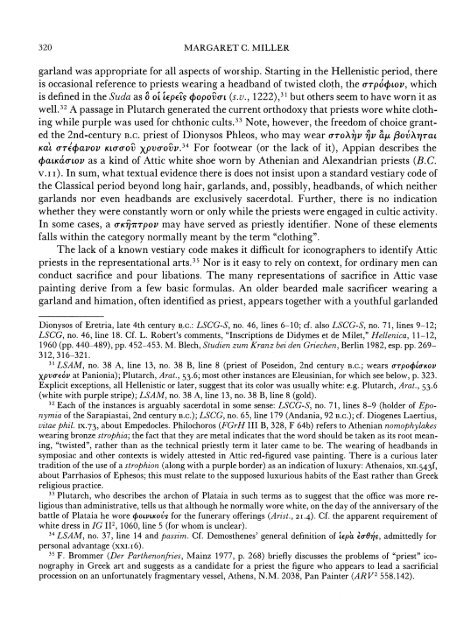the ependytes in classical athens - The American School of ...
the ependytes in classical athens - The American School of ...
the ependytes in classical athens - The American School of ...
Create successful ePaper yourself
Turn your PDF publications into a flip-book with our unique Google optimized e-Paper software.
320 MARGARET C. MILLER<br />
garland was appropriate for all aspects <strong>of</strong> worship. Start<strong>in</strong>g <strong>in</strong> <strong>the</strong> Hellenistic period, <strong>the</strong>re<br />
is occasional reference to priests wear<strong>in</strong>g a headband <strong>of</strong> twisted cloth, <strong>the</strong> -Trpo 4tov, which<br />
is def<strong>in</strong>ed <strong>in</strong> <strong>the</strong> Suda as o o' LEpELS1 opovio-t (s.v., 1222),31 but o<strong>the</strong>rs seem to have worn it as<br />
well.32 A passage <strong>in</strong> Plutarch generated <strong>the</strong> current orthodoxy that priests wore white cloth<strong>in</strong>g<br />
while purple was used for chthonic cults.33 Note, however, <strong>the</strong> freedom <strong>of</strong> choice granted<br />
<strong>the</strong> 2nd-century B.C. priest <strong>of</strong> Dionysos Phleos, who may wear -TroX7'?v 767v all "oAr0XTat<br />
Kat 0rTfE avoV KLOtOCOV Xpv-ov^.34 For footwear (or <strong>the</strong> lack <strong>of</strong> it), Appian describes <strong>the</strong><br />
OatKato-v as a k<strong>in</strong>d <strong>of</strong> Attic white shoe worn by A<strong>the</strong>nian and Alexandrian priests (B.C.<br />
V. i I). In sum, what textual evidence <strong>the</strong>re is does not <strong>in</strong>sist upon a standard vestiary code <strong>of</strong><br />
<strong>the</strong> Classical period beyond long hair, garlands, and, possibly, headbands, <strong>of</strong> which nei<strong>the</strong>r<br />
garlands nor even headbands are exclusively sacerdotal. Fur<strong>the</strong>r, <strong>the</strong>re is no <strong>in</strong>dication<br />
whe<strong>the</strong>r <strong>the</strong>y were constantly worn or only while <strong>the</strong> priests were engaged <strong>in</strong> cultic activity.<br />
In some cases, a O-Kr)7r'pOV may have served as priestly identifier. None <strong>of</strong> <strong>the</strong>se elements<br />
falls with<strong>in</strong> <strong>the</strong> category normally meant by <strong>the</strong> term "cloth<strong>in</strong>g".<br />
<strong>The</strong> lack <strong>of</strong> a known vestiary code makes it difficult for iconographers to identify Attic<br />
priests <strong>in</strong> <strong>the</strong> representational arts.35 Nor is it easy to rely on context, for ord<strong>in</strong>ary men can<br />
conduct sacrifice and pour libations. <strong>The</strong> many representations <strong>of</strong> sacrifice <strong>in</strong> Attic vase<br />
pa<strong>in</strong>t<strong>in</strong>g derive from a few basic formulas. An older bearded male sacrificer wear<strong>in</strong>g a<br />
garland and himation, <strong>of</strong>ten identified as priest, appears toge<strong>the</strong>r with a youthful garlanded<br />
Dionysos <strong>of</strong> Eretria, late 4th century B.c.: LSCG-S, no. 46, l<strong>in</strong>es 6-10; cf. also LSCG-S, no. 71, l<strong>in</strong>es 9-12;<br />
LSCG, no. 46, l<strong>in</strong>e 18. Cf. L. Robert's comments, "Inscriptions de Didymes et de Milet," Hellenica, 11-12,<br />
1960 (pp. 440-489), pp. 452-453. M. Blech, Studien zum Kranz bei den Griechen, Berl<strong>in</strong> 1982, esp. pp. 269-<br />
312,316-321.<br />
31 LSAM, no. 38 A, l<strong>in</strong>e 13, no. 38 B, l<strong>in</strong>e 8 (priest <strong>of</strong> Poseidon, 2nd century B.C.; wears o--pO4uo-KOV<br />
XpvOre<strong>of</strong>v at Panionia); Plutarch, Arat., 53.6; most o<strong>the</strong>r <strong>in</strong>stances are Eleus<strong>in</strong>ian, for which see below, p. 323.<br />
Explicit exceptions, all Hellenistic or later, suggest that its color was usually white: e.g. Plutarch, Arat., 53.6<br />
(white with purple stripe); LSAM, no. 38 A, l<strong>in</strong>e 13, no. 38 B, l<strong>in</strong>e 8 (gold).<br />
32 Each <strong>of</strong> <strong>the</strong> <strong>in</strong>stances is arguably sacerdotal <strong>in</strong> some sense: LSCG-S, no. 71, l<strong>in</strong>es 8-9 (holder <strong>of</strong> Eponymia<br />
<strong>of</strong> <strong>the</strong> Sarapiastai, 2nd century B.C.); LSCG, no. 65, l<strong>in</strong>e 179 (Andania, 92 B.C.); cf. Diogenes Laertius,<br />
vitae phil. IX.73, about Empedocles. Philochoros (FGrH III B, 328, F 64b) refers to A<strong>the</strong>nian nomophylakes<br />
wear<strong>in</strong>g bronze strophia; <strong>the</strong> fact that <strong>the</strong>y are metal <strong>in</strong>dicates that <strong>the</strong> word should be taken as its root mean<strong>in</strong>g,<br />
"twisted", ra<strong>the</strong>r than as <strong>the</strong> technical priestly term it later came to be. <strong>The</strong> wear<strong>in</strong>g <strong>of</strong> headbands <strong>in</strong><br />
symposiac and o<strong>the</strong>r contexts is widely attested <strong>in</strong> Attic red-figured vase pa<strong>in</strong>t<strong>in</strong>g. <strong>The</strong>re is a curious later<br />
tradition <strong>of</strong> <strong>the</strong> use <strong>of</strong> a strophion (along with a purple border) as an <strong>in</strong>dication <strong>of</strong> luxury: A<strong>the</strong>naios, xII.543f,<br />
about Parrhasios <strong>of</strong> Ephesos; this must relate to <strong>the</strong> supposed luxurious habits <strong>of</strong> <strong>the</strong> East ra<strong>the</strong>r than Greek<br />
religious practice.<br />
33 Plutarch, who describes <strong>the</strong> archon <strong>of</strong> Plataia <strong>in</strong> such terms as to suggest that <strong>the</strong> <strong>of</strong>fice was more religious<br />
than adm<strong>in</strong>istrative, tells us that although he normally wore white, on <strong>the</strong> day <strong>of</strong> <strong>the</strong> anniversary <strong>of</strong> <strong>the</strong><br />
battle <strong>of</strong> Plataia he wore OoLLKOVKo for <strong>the</strong> funerary <strong>of</strong>fer<strong>in</strong>gs (Arist., 21.4). Cf. <strong>the</strong> apparent requirement <strong>of</strong><br />
white dress <strong>in</strong> IG JJ2, 1060, l<strong>in</strong>e 5 (for whom is unclear).<br />
34 LSAM, no. 37, l<strong>in</strong>e 14 and passim. Cf. Demos<strong>the</strong>nes' general def<strong>in</strong>ition <strong>of</strong> LEpa ia-6e1jS, admittedly for<br />
personal advantage (xxi. i 6).<br />
35 F. Brommer (Der Par<strong>the</strong>nonfries, Ma<strong>in</strong>z 1977, p. 268) briefly discusses <strong>the</strong> problems <strong>of</strong> "priest" iconography<br />
<strong>in</strong> Greek art and suggests as a candidate for a priest <strong>the</strong> figure who appears to lead a sacrificial<br />
procession on an unfortunately fragmentary vessel, A<strong>the</strong>ns, N.M. 2038, Pan Pa<strong>in</strong>ter (AR V2 558.142).

















